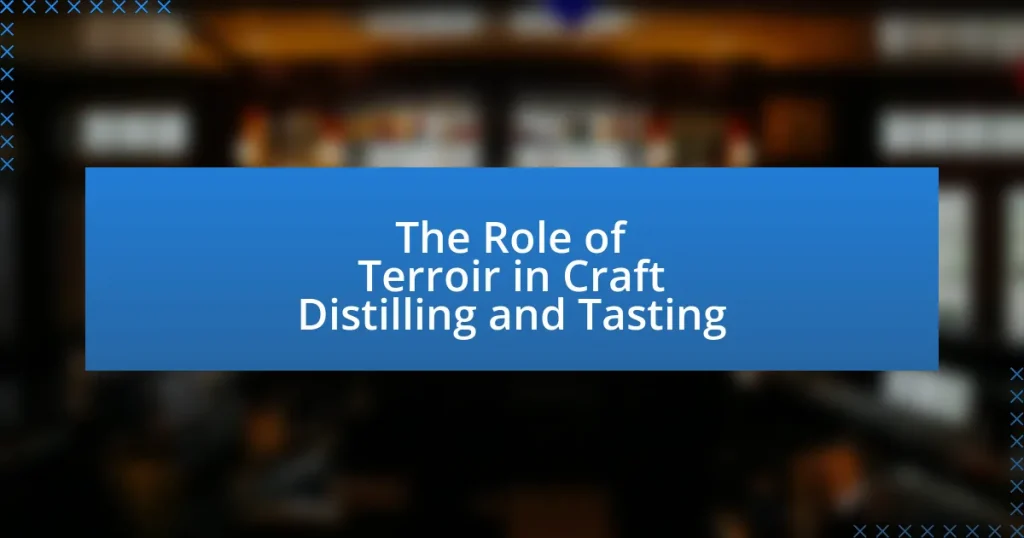The article examines the critical role of terroir in craft distilling and tasting, highlighting how environmental factors such as soil composition, climate, and local agricultural practices influence the flavor profiles of distilled spirits. It discusses the impact of terroir on raw materials like grains, fruits, and botanicals, and how these elements contribute to the uniqueness of spirits from different regions. The article also explores the sensory implications of terroir in tasting experiences, consumer perceptions, and marketing strategies, emphasizing the importance of local sourcing for authenticity in craft distilling. Additionally, it outlines practical tips for distillers to leverage terroir in their production processes.

What is the Role of Terroir in Craft Distilling and Tasting?
Terroir plays a crucial role in craft distilling and tasting by influencing the flavor profile and characteristics of distilled spirits. The specific environmental conditions, including soil composition, climate, and local agricultural practices, directly affect the raw materials used in distillation, such as grains, fruits, or botanicals. For instance, the unique terroir of a region can impart distinct flavors to whiskey made from locally sourced grains, as seen in the variations between Scotch whiskies from different regions of Scotland. This concept is supported by studies indicating that terroir can significantly impact the chemical composition of the ingredients, thereby altering the final product’s taste and aroma.
How does terroir influence the characteristics of distilled spirits?
Terroir significantly influences the characteristics of distilled spirits by affecting the raw materials used, such as grains, fruits, or sugarcane, and the environmental conditions during their growth. The unique combination of soil composition, climate, and local agricultural practices imparts distinct flavors and aromas to the ingredients, which are then carried through the distillation process. For example, whiskey produced in Scotland often exhibits peaty and smoky notes due to the local barley and water sources, while tequila from Jalisco, Mexico, reflects the mineral-rich soil and specific agave varieties. This relationship between the environment and the final product is well-documented, as seen in studies highlighting how geographical factors contribute to the sensory profiles of spirits, thus validating the importance of terroir in craft distilling.
What elements constitute terroir in the context of distilling?
Terroir in the context of distilling is constituted by the geographical location, climate, soil composition, and local agricultural practices. These elements influence the raw materials used in distillation, such as grains, fruits, or botanicals, which in turn affect the flavor profile and character of the final spirit. For instance, the mineral content of the soil can impart distinct flavors to the crops grown, while the climate can affect the maturation process of spirits, as seen in whiskey production where temperature variations influence aging. This relationship between the environment and the product is well-documented in studies of regional spirits, highlighting how local conditions shape unique characteristics in distillates.
How do soil, climate, and geography affect flavor profiles?
Soil, climate, and geography significantly influence flavor profiles by affecting the growth conditions of crops used in distilling. Soil composition determines nutrient availability and water retention, which directly impacts the flavor compounds produced in plants. For instance, volcanic soils are known to impart unique mineral qualities to grapes, enhancing the complexity of wine flavors. Climate affects temperature and precipitation patterns, influencing the ripening process and the concentration of sugars and acids in fruits. For example, warmer climates can lead to higher sugar levels, resulting in sweeter flavor profiles. Geography, including elevation and proximity to bodies of water, can create microclimates that further refine flavor characteristics. Research indicates that these factors collectively shape the sensory attributes of distilled products, as seen in the distinct profiles of spirits from different regions, such as the terroir of Scotch whisky versus bourbon.
Why is understanding terroir important for craft distillers?
Understanding terroir is crucial for craft distillers because it directly influences the flavor profile and quality of their spirits. Terroir encompasses the unique environmental factors, such as soil composition, climate, and local agricultural practices, that affect the raw materials used in distillation. For instance, the specific minerals in the soil can impart distinct characteristics to grains or fruits, which in turn shape the final product’s taste. Research has shown that spirits produced from ingredients grown in diverse terroirs exhibit significant variations in flavor, highlighting the importance of local sourcing for authenticity and uniqueness in craft distilling.
How does terroir contribute to the uniqueness of craft spirits?
Terroir contributes to the uniqueness of craft spirits by influencing the flavor profile and characteristics of the ingredients used in production. The specific environmental factors such as soil composition, climate, and local water sources affect the growth of crops like grains, fruits, and botanicals, which are essential for distillation. For instance, the mineral content of water can alter the taste of spirits, as seen in Scotch whisky, where the water source is integral to its flavor. Additionally, the local climate can impact the maturation process in barrels, leading to distinct flavor notes that reflect the region’s characteristics. This interplay of environmental elements creates a signature style for craft spirits that is often tied to their geographic origin, making them unique compared to mass-produced alternatives.
What role does terroir play in consumer perception and marketing?
Terroir significantly influences consumer perception and marketing by shaping the unique characteristics of a product, which consumers associate with quality and authenticity. This concept encompasses the environmental factors, such as soil, climate, and geography, that affect the flavor profile of spirits, leading consumers to perceive products as more premium when they are tied to specific regions known for their distinct terroir. For instance, research indicates that consumers are willing to pay up to 20% more for spirits that highlight their terroir, as it enhances the narrative of craftsmanship and tradition, thereby increasing brand loyalty and market differentiation.

How do different regions express terroir in their craft distilling?
Different regions express terroir in their craft distilling through unique local ingredients, climate conditions, and traditional production methods. For instance, the use of specific grains, fruits, or botanicals native to a region influences the flavor profile of the spirits produced. In Scotland, the distinct peat used in whisky production imparts a smoky flavor, while in the American South, the use of corn and the influence of humidity during aging create sweeter, fuller-bodied spirits. Additionally, variations in water source, such as mineral content, can significantly affect the final product’s taste. These regional characteristics are often highlighted in marketing and tasting notes, reinforcing the connection between the distillate and its geographical origin.
What are some notable regions known for their distinct terroir?
Notable regions known for their distinct terroir include Bordeaux in France, Napa Valley in California, and the Barossa Valley in Australia. Bordeaux is recognized for its unique blend of climate, soil, and grape varieties, particularly Merlot and Cabernet Sauvignon, which contribute to its world-renowned wines. Napa Valley’s diverse microclimates and volcanic soils create ideal conditions for high-quality Cabernet Sauvignon and Chardonnay. The Barossa Valley’s warm climate and rich, fertile soils produce robust Shiraz wines, showcasing the region’s distinct terroir. Each of these regions exemplifies how local environmental factors influence the characteristics of the beverages produced.
How does the terroir of Scotland differ from that of Kentucky?
The terroir of Scotland differs from that of Kentucky primarily due to variations in climate, soil composition, and water sources. Scotland’s cooler, wetter climate, characterized by high humidity and frequent rainfall, influences the growth of barley and the maturation of whisky, while its diverse soils, ranging from peaty to sandy, impart distinct flavors to the spirits. In contrast, Kentucky’s warmer climate, with hot summers and cold winters, along with its limestone-rich soil, contributes to a different flavor profile in bourbon, as the limestone filters iron from the water, enhancing the sweetness of the corn used in production. These environmental factors create unique characteristics in the whiskies produced in each region, with Scotland often showcasing more earthy and smoky notes, while Kentucky bourbons tend to be sweeter and fuller-bodied.
What unique characteristics do different regions impart to their spirits?
Different regions impart unique characteristics to their spirits primarily through variations in climate, soil composition, and local ingredients. For instance, whiskey from Scotland often exhibits a peaty flavor due to the use of local barley and the influence of the region’s damp climate, which affects the malting process. In contrast, tequila from Mexico showcases the distinct flavor of blue agave, which thrives in the region’s specific soil and climate conditions, resulting in a sweeter, more herbal profile. Additionally, rum produced in the Caribbean often reflects the tropical climate and sugarcane varieties, leading to a rich, fruity taste. These regional factors, including historical production methods and local water sources, significantly shape the flavor profiles and overall characteristics of the spirits produced in those areas.
How do local ingredients interact with terroir in distilling?
Local ingredients significantly influence terroir in distilling by imparting unique flavors and characteristics that reflect the specific environmental conditions of their origin. Terroir encompasses factors such as soil composition, climate, and local agricultural practices, which together shape the sensory profile of distilled spirits. For instance, grains grown in mineral-rich soils can produce spirits with distinct earthy notes, while fruits harvested in a particular climate may yield more vibrant and aromatic profiles. This interaction between local ingredients and terroir is evident in products like whiskey, where the water source and grain variety contribute to the final taste, as seen in the distinct profiles of Scotch versus Bourbon, which are influenced by their respective regional ingredients and environmental factors.
What types of local grains and botanicals are commonly used?
Local grains commonly used in craft distilling include corn, barley, rye, and wheat, while botanicals often consist of juniper berries, coriander, angelica root, and various herbs and spices. These grains provide the base for spirits like whiskey and gin, with corn being predominant in bourbon production, which accounts for over 95% of the grain bill. Botanicals, particularly juniper, are essential for flavoring gin, with the use of local herbs enhancing the unique characteristics of the final product. The specific choice of grains and botanicals reflects the terroir, influencing the flavor profile and quality of the distilled spirits.
How do these ingredients enhance the expression of terroir?
Ingredients such as local grains, water sources, and yeast strains enhance the expression of terroir by imparting unique flavors and characteristics that reflect the specific environment in which they are produced. Local grains absorb the minerals and nutrients from the soil, influencing the taste profile of the final product. Water sources, particularly those with distinct mineral compositions, can alter the mouthfeel and overall flavor. Additionally, indigenous yeast strains contribute to fermentation nuances, further distinguishing the spirit’s flavor based on regional characteristics. This interplay of ingredients and environment creates a distinctive identity for the spirit, showcasing the essence of its terroir.

What are the sensory implications of terroir in tasting craft spirits?
The sensory implications of terroir in tasting craft spirits are significant, as they influence the flavor profile, aroma, and mouthfeel of the spirits. Terroir encompasses the unique environmental factors such as soil composition, climate, and local flora that affect the ingredients used in distillation, particularly grains, fruits, and botanicals. For instance, a study published in the Journal of Agricultural and Food Chemistry found that the mineral content of soil can directly impact the taste of the crops grown, which in turn affects the final spirit. This means that a whiskey produced in one region may have distinct notes of earthiness or sweetness compared to one made in another area, reflecting the local terroir. Additionally, the fermentation process can be influenced by local yeast strains, further contributing to the complexity of flavors experienced during tasting.
How can consumers identify terroir in the tasting experience?
Consumers can identify terroir in the tasting experience by recognizing specific flavor profiles and aromas that reflect the geographical and environmental conditions of the product’s origin. Terroir influences the taste of beverages, such as wine and spirits, through factors like soil composition, climate, and local agricultural practices. For example, a whiskey distilled in Scotland may exhibit peaty notes due to the region’s unique soil and climate, while a bourbon from Kentucky may have sweeter, corn-forward flavors influenced by the local grain used. These distinct characteristics allow consumers to discern the terroir, enhancing their appreciation of the product’s authenticity and connection to its origin.
What specific flavors and aromas are associated with different terroirs?
Different terroirs are associated with specific flavors and aromas that reflect the unique environmental conditions of each region. For example, terroirs in cooler climates, such as those in northern France, often produce wines with higher acidity and flavors of green apple and citrus, while warmer regions like California yield wines with ripe fruit flavors such as peach and tropical notes. Additionally, terroirs with volcanic soils, like those in parts of Italy, impart mineral qualities and earthy aromas, while regions with clay soils may enhance richness and body, contributing to flavors of dark fruits and spices. These associations are supported by studies, such as those published in the Journal of Wine Research, which highlight how soil composition, climate, and topography influence the sensory characteristics of wines.
How does terroir affect the mouthfeel and finish of spirits?
Terroir significantly influences the mouthfeel and finish of spirits by imparting unique characteristics derived from the local environment, including soil composition, climate, and water source. These factors affect the raw materials used in distillation, such as grains or fruits, which in turn shape the texture and lingering sensations of the final product. For example, spirits produced in regions with mineral-rich water often exhibit a smoother mouthfeel, while those from areas with high humidity may have a more pronounced finish due to the interaction of the spirit with the barrel during aging. Studies have shown that the specific terroir can lead to distinct flavor profiles and tactile experiences, reinforcing the importance of geographical origin in the overall sensory experience of spirits.
What techniques can enhance the appreciation of terroir in tasting?
Techniques that can enhance the appreciation of terroir in tasting include sensory analysis, comparative tasting, and contextual education. Sensory analysis involves focusing on the specific aromas, flavors, and textures that reflect the unique characteristics of the local environment, such as soil composition and climate. Comparative tasting allows individuals to sample products from different regions side by side, highlighting how terroir influences flavor profiles. Contextual education, which includes learning about the history, geography, and agricultural practices of a region, provides a deeper understanding of how these factors contribute to the final product. These techniques collectively foster a more nuanced appreciation of terroir in tasting experiences.
How can tasting notes be effectively recorded to reflect terroir?
Tasting notes can be effectively recorded to reflect terroir by systematically documenting specific sensory attributes linked to the geographical and environmental conditions of the source. This includes noting the aroma, flavor, mouthfeel, and finish of the spirit, while also incorporating descriptors that relate to the local soil, climate, and agricultural practices. For instance, a whiskey produced in a coastal region may exhibit briny notes due to the maritime influence, while a spirit from a mountainous area might showcase herbal or floral characteristics tied to the local flora. By using standardized terminology and detailed descriptions, tasters can create a comprehensive record that highlights the unique qualities imparted by the terroir, thus providing a clearer understanding of how place influences flavor.
What are best practices for conducting a terroir-focused tasting?
Best practices for conducting a terroir-focused tasting include selecting representative samples from distinct terroirs, ensuring proper glassware for aroma and flavor assessment, and providing context about the origin of each sample. By choosing samples that highlight the unique characteristics of their geographical and environmental conditions, tasters can better appreciate the influence of terroir on flavor profiles. Using appropriate glassware enhances the sensory experience, allowing for a more accurate evaluation of aromas and tastes. Additionally, sharing information about the soil, climate, and cultivation methods of each sample helps participants understand the connection between terroir and the resulting flavors, reinforcing the significance of place in the tasting experience.
What practical tips can help distillers leverage terroir in their craft?
Distillers can leverage terroir by sourcing local ingredients, which enhances the unique characteristics of their spirits. Utilizing locally grown grains, fruits, or botanicals allows distillers to reflect the specific environmental conditions, such as soil composition and climate, in their products. For example, a study by the American Distilling Institute highlights that spirits made from local grains often exhibit distinct flavor profiles that resonate with the region’s terroir. Additionally, distillers should consider the influence of local water sources, as mineral content can significantly affect the final taste. Engaging with local farmers and producers fosters a deeper connection to the land, further enriching the distillation process and resulting in a product that embodies the essence of its origin.


